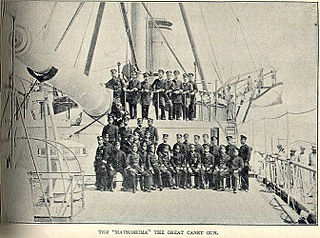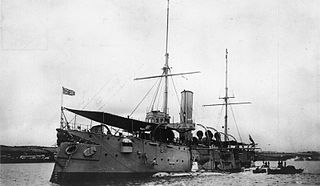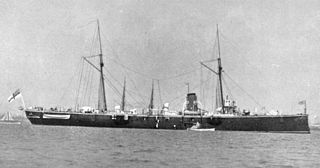
A torpedo boat is a relatively small and fast naval ship designed to carry torpedoes into battle. The first designs were steam-powered craft dedicated to ramming enemy ships with explosive spar torpedoes. Later evolutions launched variants of self-propelled Whitehead torpedoes.

The armored cruiser was a type of warship of the late 19th and early 20th centuries. It was designed like other types of cruisers to operate as a long-range, independent warship, capable of defeating any ship apart from a battleship and fast enough to outrun any battleship it encountered.

Protected cruisers, a type of cruising warship of the late-19th century, gained their description because an armoured deck offered protection for vital machine-spaces from fragments caused by shells exploding above them. Protected cruisers resembled armored cruisers, which had in addition a belt of armour along the sides.

A warship or combatant ship is a naval ship that is built and primarily intended for naval warfare. Usually they belong to the armed forces of a state. As well as being armed, warships are designed to withstand damage and are typically faster and more maneuverable than merchant ships. Unlike a merchant ship, which carries cargo, a warship typically carries only weapons, ammunition and supplies for its crew. Warships usually belong to a navy, though they have also been operated by individuals, cooperatives and corporations.

Steam frigates and the smaller steam corvettes, steam sloops, steam gunboats and steam schooners, were steam-powered warships that were not meant to stand in the line of battle. There were some exceptions like for example the French Napoléon class steam ship of the line was meant to stand in the line of battle, making it the world's first steam battleship. The first such ships were paddle steamers. Later on the invention of screw propulsion enabled construction of steam-powered versions of the traditional ships of the line, frigates, corvettes, sloops and gunboats.

The Arethusa-class cruisers were a class of eight oil-fired light cruisers of the Royal Navy all ordered in September 1912, primarily for service in the North Sea. They had three funnels with the middle one somewhat larger in diameter than the others. All served in the First World War. They were found to be very cramped internally.

HMS Arethusa was the name ship of her class of eight light cruisers built for the Royal Navy in the 1910s. She saw a considerable amount of action during the early years of the First World War, participating in the Battle of Heligoland Bight and the Battle of Dogger Bank.

HMS Southampton was a Town-class light cruiser built for the Royal Navy in the 1910s. She was a member of the Chatham sub-class of the Town class. The ship survived the First World War and was sold for scrap in 1926.

The Canet guns were a series of weapon systems developed by the French engineer Gustave Canet (1846–1908), who worked as an engineer from 1872 to 1881 for the London Ordnance Works, then for Forges et Chantiers de la Méditerranée, and from 1897 to 1907 for Schneider et Cie of Le Creusot.

The Orlando class was a seven ship class of Royal Navy armoured cruisers completed between 1888 and 1889.

The two Naniwa-class cruisers were protected cruisers built for the Imperial Japanese Navy (IJN) during the 1880s. As Japan lacked the industrial capacity to build such warships herself, the vessels were built in Britain. Both ships participated in numerous actions during the First Sino-Japanese War of 1894–1895 and in the Russo-Japanese War of 1904–1905.

HMS Thames was a Mersey-class protected cruiser built for the Royal Navy (RN) in the 1880s. The ship was placed in reserve upon her completion in 1888 and was converted into a submarine depot ship in 1903. She was sold out of the navy in 1920 and was purchased by a South African businessman to serve as a training ship for naval cadets under the name SATS General Botha. The ship arrived in South Africa in 1921 and began training her first class of cadets in Simon's Town the following year. General Botha continued to train cadets for the first several years of World War II, but the RN took over the ship in 1942 for use as an accommodation ship under her original name. She was scuttled by gunfire in 1947 and is now a diveable wreck.

HMS Severn was a Humber-class monitor of the Royal Navy. Originally built by Vickers for Brazil, she was purchased by the Royal Navy in 1914 on the outbreak of the First World War along with her sister ships Humber and Mersey. She had been christened Solimoes by the Brazilians, but was renamed by the British. The three ships were the first of a new type of specialized shore-bombardment warships. As a result of her shallow draught, she was very un-manoeuvrable and unseaworthy in open waters in anything more than a Force 5 wind.

The Iris class consisted of two ships, HMS Iris and HMS Mercury, built for the Royal Navy in the 1870s. They were the first British all-steel warships.

HMS Mercury was one of two Iris-class despatch vessels, later redesignated as second class cruiser built for the Royal Navy during the 1870s. The two ships were the first all-steel warships in the Royal Navy.

The Camelion class was a class of screw-driven sloops of wood construction, designed by Isaac Watts and operated by the Royal Navy. Eight ships of the class were built from 1858 to 1866 with another eight cancelled. They were initially rated as second-class sloops, but were later reclassified as corvettes.

The Marathon-class cruiser was a class of second class cruiser of the Royal Navy ordered under the naval programme of 1887. The class was a smaller version of the Mersey class.

The Mariner class was a class of six 8-gun gunvessels built for the Royal Navy between 1883 and 1888. Four were built in the Naval Dockard at Devonport, and two elsewhere; the Acorn was built by contract at Jacobs Pill on the Pembroke River, while the Melita was built in the Malta Dockyard, the only substantial ship of the Royal Navy ever to be built in the island.

The Comus class was a class of Royal Navy steam corvettes, re-classified as third-class cruisers in 1888. All were built between 1878 and 1881. The class exemplifies the transitional nature of the late Victorian navy. In design, materials, armament, and propulsion the class members resemble their wooden sailing antecedents, but blended with characteristics of the all-metal mastless steam cruisers which followed.

The Mersey-class cruiser was a class of second class protected cruiser of the Royal Navy commissioned in the late 1880s.


















